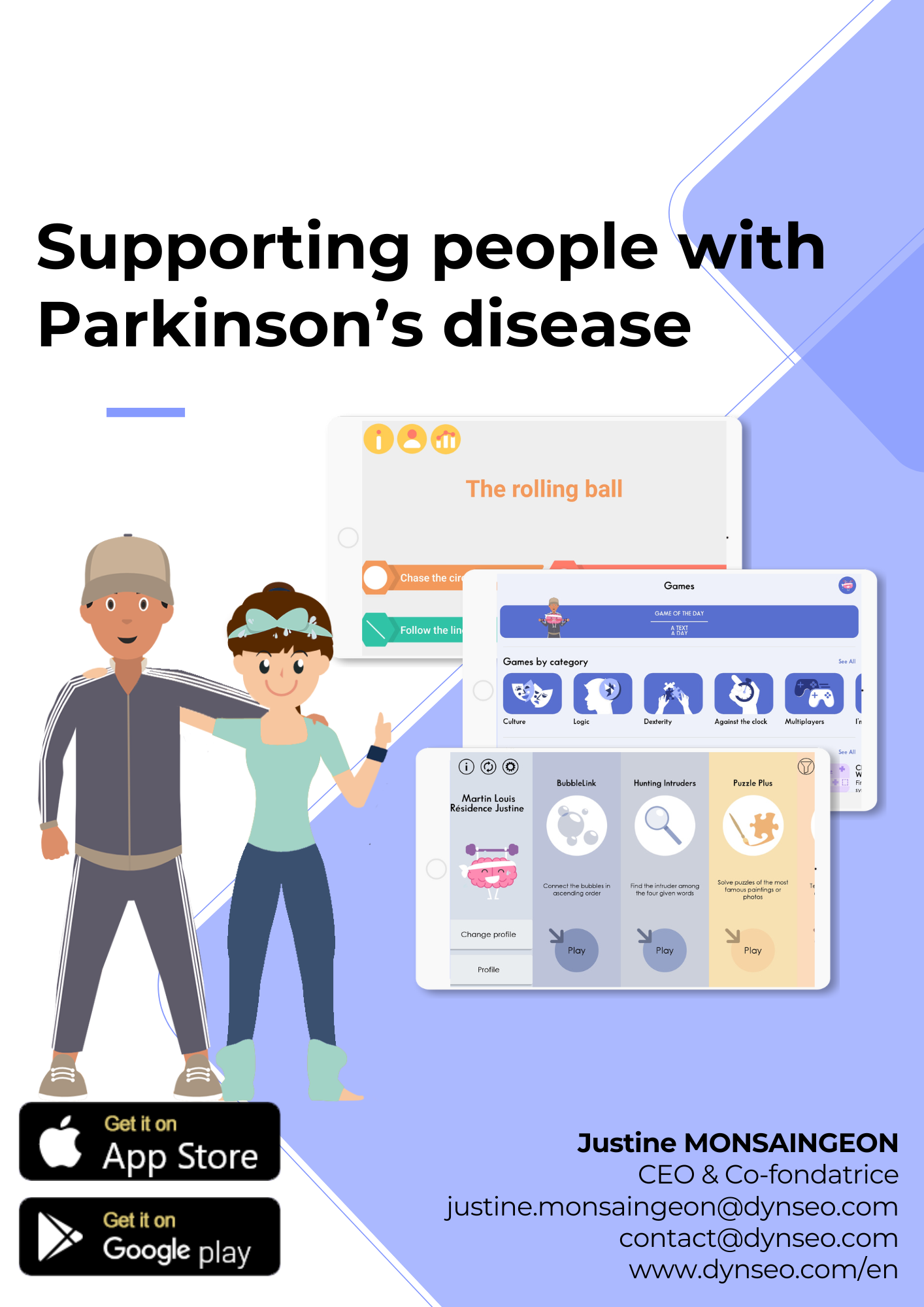Parkinson’s disease, a progressive neurological disorder, poses significant challenges to patients, caregivers, and healthcare professionals alike. Characterized by symptoms such as tremors, rigidity, and impaired balance and coordination, Parkinson’s significantly impacts an individual’s quality of life and daily functioning. As the disease advances, managing its symptoms becomes increasingly complex and demanding.
In recent years, the integration of technology and mobile applications has emerged as a promising avenue for aiding Parkinson’s patients in their day-to-day struggles. These innovative solutions offer a range of functionalities, from symptom tracking and medication management to virtual rehabilitation and remote monitoring. The importance of technological interventions cannot be overstated, as they empower patients to take more control over their health while enhancing communication and collaboration between patients and healthcare providers.
This introduction sets the stage for exploring the various ways in which technology and apps can serve as invaluable tools in the comprehensive management of Parkinson’s disease, ultimately striving towards improving patient outcomes and enhancing overall well-being.
Understanding Parkinson’s Disease
Parkinson’s disease presents a complex array of symptoms and challenges that profoundly affect both patients and their caregivers. The hallmark symptoms include tremors, muscle rigidity, bradykinesia (slowed movement), and postural instability, which can vary in severity and progression among individuals. These symptoms not only impair physical movements but also impact cognitive function and emotional well-being, contributing to a range of challenges in daily living. Simple tasks such as dressing, eating, and walking become arduous as the disease progresses. Parkinson’s also disrupts communication abilities and can lead to social isolation and depression.
The relentless nature of the disease demands constant adaptation and management strategies to cope with its multifaceted impact on every aspect of daily life. Understanding these symptoms and challenges is crucial for developing effective interventions to support Parkinson’s patients in maintaining their independence and quality of life.
Current Treatment Landscape
In the current treatment landscape for Parkinson’s disease, medications and therapies play a central role in managing symptoms and improving quality of life for patients. Dopamine agonists, levodopa, and MAO-B inhibitors are among the most commonly prescribed medications to alleviate motor symptoms such as tremors and stiffness. Additionally, physical therapy, occupational therapy, and speech therapy are integral components of comprehensive treatment plans, aiming to maintain mobility, enhance communication, and promote independence.
However, these treatments come with inherent limitations and side effects. Over time, the effectiveness of medication may diminish, leading to fluctuations in symptom control and dyskinesias. Moreover, some medications can cause adverse effects such as nausea, hallucinations, and orthostatic hypotension, further complicating the management of Parkinson’s disease. As such, there is a pressing need for continued research and innovation to develop safer and more efficacious treatment modalities that address the limitations and mitigate the side effects associated with existing therapies.
Role of Technology in Parkinson’s Management
The role of technology in Parkinson’s management has revolutionized the way symptoms are monitored and treatments are adhered to. Wearable devices equipped with sensors offer real-time tracking of movement patterns, tremors, and other motor symptoms, providing valuable insights into disease progression and treatment efficacy. These devices enable continuous monitoring outside clinical settings, empowering patients and caregivers with actionable data for timely interventions and adjustments to treatment plans. Furthermore, mobile applications designed specifically for Parkinson’s patients offer features such as medication reminders, symptom diaries, and exercise routines tailored to individual needs.
By integrating technology into daily routines, these applications enhance medication adherence and promote proactive self-management, ultimately improving symptom control and quality of life for individuals living with Parkinson’s disease.
Assistive Technologies for Parkinson’s Patients
Assistive technologies have emerged as invaluable aids for Parkinson’s patients, offering enhanced accessibility and independence in daily tasks. Voice-activated assistants, like Amazon’s Alexa or Google Assistant, provide hands-free assistance for various activities such as setting reminders, scheduling appointments, and controlling smart home devices. These assistants alleviate the challenges posed by motor impairments and tremors, enabling seamless interaction with technology and facilitating greater autonomy.
Moreover, smart home devices equipped with voice control and automation features enhance accessibility by allowing individuals to adjust lighting, temperature, and security systems with simple voice commands. By integrating these technologies into their living spaces, Parkinson’s patients can navigate their environments more comfortably and efficiently, fostering a sense of empowerment and improving overall quality of life.
Rehabilitation and Therapy Apps
Rehabilitation and therapy apps offer innovative solutions for Parkinson’s patients to engage in effective motor skills and cognitive training from the comfort of their homes. Virtual reality (VR) applications immerse users in interactive environments designed to simulate real-life scenarios for motor skills training. Through VR, patients can practice balance exercises, gait training, and fine motor movements in a safe and controlled setting, fostering neuroplasticity and improving motor function over time. Additionally, cognitive training applications provide targeted exercises to enhance memory, attention, and problem-solving skills, addressing the cognitive impairments commonly associated with Parkinson’s disease.
These apps offer personalized training programs and progress tracking features, empowering patients to actively participate in their rehabilitation journey while receiving immediate feedback and support. By leveraging the capabilities of technology, rehabilitation and therapy apps offer accessible and engaging avenues for Parkinson’s patients to optimize their physical and cognitive abilities, ultimately promoting greater independence and quality of life.
Remote Monitoring and Telemedicine
Remote monitoring and telemedicine have revolutionized Parkinson’s care by providing convenient access to healthcare professionals and continuous monitoring of disease progression. Telemedicine platforms enable patients to schedule remote consultations with neurologists and other specialists from the comfort of their homes, eliminating the need for frequent and often challenging in-person visits. These virtual appointments facilitate timely assessments, medication adjustments, and personalized treatment plans, enhancing patient-centered care and improving health outcomes.
Furthermore, remote monitoring systems utilize wearable devices and digital health tools to track key indicators of disease progression, such as motor symptoms, medication adherence, and fluctuations in movement patterns. By collecting and analyzing real-time data, healthcare providers can proactively intervene and tailor interventions to meet individual needs, optimizing symptom management and enhancing the quality of life for Parkinson’s patients.
Data Analytics and Predictive Models
In Parkinson’s disease management, data analytics and predictive models hold tremendous potential for improving treatment outcomes and patient care. By leveraging large datasets of patient information, researchers and healthcare professionals can gain valuable insights into disease progression, treatment response, and symptom patterns. These insights enable the development of predictive models that forecast the progression of Parkinson’s symptoms and identify individuals at higher risk of complications. Moreover, data analytics techniques allow for the exploration of complex relationships between various clinical variables, guiding treatment decisions and personalized interventions tailored to each patient’s unique needs.
Machine Learning Algorithms for Symptom Prediction
Machine learning algorithms offer a powerful tool for predicting Parkinson’s disease symptoms and progression. By analyzing vast amounts of patient data, including demographic information, genetic markers, and clinical assessments, machine learning models can identify patterns and trends that may indicate the onset or progression of specific symptoms.
These algorithms enable early detection of symptom exacerbations and help healthcare providers anticipate changes in disease severity, facilitating timely interventions and adjustments to treatment plans. By harnessing the predictive capabilities of machine learning, clinicians can optimize patient care, improve symptom management, and enhance the overall quality of life for individuals living with Parkinson’s disease.
Data Analysis for Treatment Optimization
Data analysis plays a crucial role in optimizing treatment strategies for Parkinson’s patients. By examining treatment response data, medication adherence rates, and symptom fluctuations over time, healthcare providers can identify patterns and trends that inform treatment optimization efforts. Through advanced statistical techniques and data visualization tools, clinicians can assess the efficacy of current treatment regimens, identify areas for improvement, and tailor interventions to meet individual patient needs.
Moreover, data analysis allows for the identification of potential adverse effects or drug interactions, guiding the selection of safer and more effective treatment options. By continuously analyzing treatment data and patient outcomes, healthcare providers can refine treatment protocols, optimize symptom management, and improve the overall quality of care for Parkinson’s patients.
User Experience and Accessibility Considerations
In designing user-friendly interfaces for healthcare applications, it’s crucial to integrate accessibility features catering to patients with disabilities. A user-friendly interface encompasses intuitive design, clear navigation, and minimal cognitive load, ensuring patients can easily navigate through the application. Simultaneously, ensuring accessibility for patients with disabilities involves incorporating features such as screen reader compatibility, keyboard navigation, and alternative text for images to facilitate access for visually impaired individuals.
By prioritizing both aspects, healthcare applications can offer inclusive experiences, empowering patients of all abilities to access vital healthcare information and services seamlessly. This commitment to accessibility not only enhances usability but also upholds the principles of equality and inclusivity in healthcare delivery.
Challenges and Future Directions
As healthcare systems evolve, challenges and future directions intersect around privacy and security concerns alongside the integration of emerging technologies. The advent of digital healthcare introduces novel risks about patient data privacy and system security, necessitating robust measures to safeguard sensitive information against breaches and unauthorized access.
Concurrently, integrating emerging technologies like artificial intelligence and Internet of Things devices presents opportunities to enhance patient care and streamline healthcare processes. However, this integration demands careful consideration of data protection protocols and regulatory compliance to mitigate potential vulnerabilities. As healthcare continues to embrace technological advancements, addressing privacy and security concerns while effectively leveraging emerging technologies will be pivotal in fostering trust, innovation, and sustainable progress within the healthcare ecosystem.
The technological advancements in Parkinson’s care offer a multitude of benefits, ranging from remote monitoring to personalized treatment approaches. These innovations have revolutionized the management of Parkinson’s disease, providing patients with improved quality of life and more efficient healthcare delivery. However, our journey towards combating Parkinson’s is far from over. There remains a critical need for continued innovation and collaboration within the healthcare community to further refine existing technologies and develop new solutions tailored to the unique needs of Parkinson’s patients.
By fostering an environment of relentless innovation and commitment to improving patient outcomes, we can propel the field of Parkinson’s care forward, empowering both patients and healthcare professionals to confront the challenges of this complex neurological disorder with renewed vigor and optimism.




